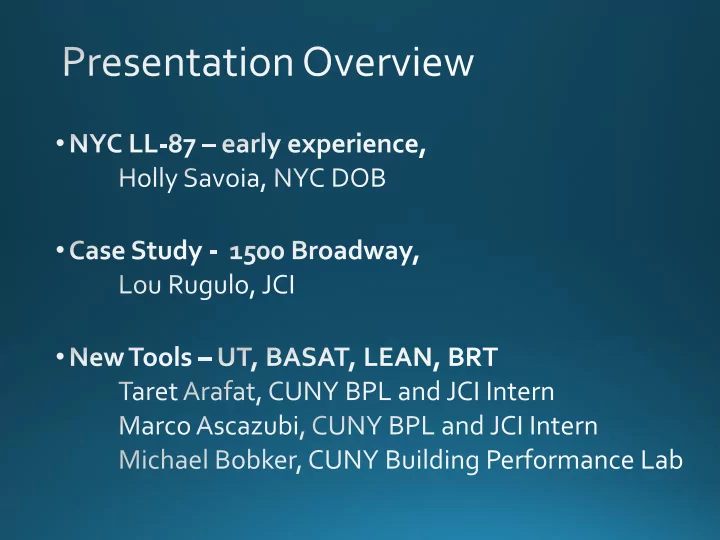

Lou Rugulo Michael Bobker Johnson Controls CUNY Building Performance Lab Marco Ascazubi Tarek Arafat JCI/CUNY BPL Interns ASHRAE-NY and AEE-NY 4-22-14
http://www.peci.org/model-commissioning-plans-guide- specifications
• Key flows, temperatures, sequences • BAS as data source + test instrument
RCx shown to have many kinds of benefits • Energy operating costs • Equipment life extension • Thermal comfort & IAQ • Productivity & labor costs
Savings from reduced OA result from less heating and cooling of OA air, calculated as approx. $39,000 per year
Based on the Energy Use Breakdown, the building uses 306,662 kWh for pumps. If we simplify, and assume the CW and CHW pumps are identical, then each uses 153,331 kWh.
Inverse modeling based on monthly data - Regression analysis of energy use against monthly average outdoor temperatures, originally for M&V use. Statistical validation. - ASHRAE Inverse Modeling Toolkit , from work by Dr. Kelly Kissock - Pre-site visit view of energy-use pattern without knowledge of building systems 3-4-5 Parameter Change-Point Model • Left slope shows heating • Right slope shows cooling • Change-points show balance temperatures • Baseloads Compare these across population to assess reduction opportunity
• JCI use of LEAN, based on a population of buildings in their databases, to provide broadly quantified recommendations • Front-end tool, before going to field for any investigation • Note the separate Electric and Fuel plots
5-Parameter Model for Steam at 1500 RCx Investigation Guidance • Steam cooling dominates – focus • High baseload and low heating change-point – simultaneous heating & cooling? High ventilation
TEMPERATURES COILS / VALVES Mixed Air Temperature Pre-Heat Entering Temperature Supply Air Temperature Pre-Heat Leaving Temperature Supply Air Temperature Setpoint Chilled Water Coil Valve Position Exhaust Air Temperature Chilled Water Coil Valve Position Setpoint Return Air Temperature Chilled Water Entering Temperature Supply Air Relative Humidity Chilled Water Leaving Temperature Re-Heat Entering Temperature DAMPER POSITIONS Re-Heat Leaving Temperature Outside Air Damper Position Heating Coil Valve Position Return Air Damper Position Heating Coil Valve Position Setpoint Exhaust Air Damper Position Re-Heat Coil Valve Position FANS Pre-Heat Coil Valve Position Supply Fan Speed FILTER Supply Fan Current Air Filter Pressure Differential Supply Fan Status Return Fan Speed Return Fan Current Return Fan Status Duct Static Pressure Duct Static Pressure Setpoint Air Volume
Availability Building Information List of data points available Notes Capabilities List of points to add Additional points need for each capability
BAS Capability: Detect instances of simultaneous heating and cooling Points Required: • Chilled Water Coil Valve Position • Re-Heat and/or Pre-Heat Coil Valve Position or Terminal Re-heat POSSIBLE AHU DETECTION CAPABILITIES Available? Additional data needed for fault detection:
Evaluate Amount of Ventilation Air Points Required: Mixed Air Temp Outside Air Fraction OR (calculated as a virtual Outdoor Air Temp point from MA, OA, RA) Return Air Temp POSSIBLE AHU DETECTION CAPABILITIES Available? Additional data needed for fault detection: Determine the Outside Air Fraction No Mixed Air Temperature
What is UT? UT is a software tool for the management and analysis of data from multiple loggers and trend data from BAS. Provides mathematical tools for data • management of multiple sensors and data collection devices on different pieces of UT User Interface equipment Synchronizes varying time intervals between • data sets Example - Change between interval and • state-change readings
Change-of-state raw sensor readings Date converted to 5-minute interval EASY CONVERSION TO FIVE MINUTE INTERVAL, MATCHING OTHER FLOW NOTE ERRATIC TIME INTERVALS DATA
1. What NYC Local Law requires retro-commissioning, for what buildings and on what schedule? A: NYC LL 87 requires RCx for all buildings of 50,000 sf and larger, on a 10-year cycle 2. What is investigated by the retro-commissioning process? A: Operation of major building systems for performance per specification and/or best possible efficiency. 3. How are Building Automation Systemsinvolved in RCx? A: As an object of evaluation for correct implementation of design intent and as a tool for observing and testing the operating sequences of equipment and systems. 4. What is LEAN Energy Analysis? A: A regression method for identifying areas of energy use and reduction opportunities based on monthly energy use data and outside air temperatures 5. What is Building Re-Tuning (BRT)? A: A protocol aimed at training building operators to implement on-going commissioning practices
Recommend
More recommend